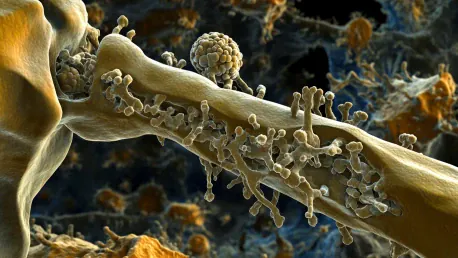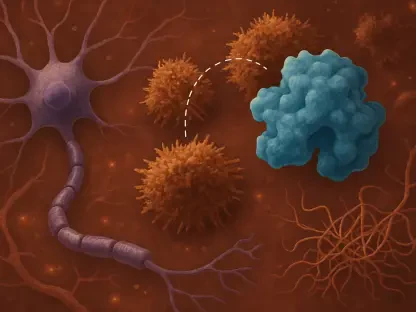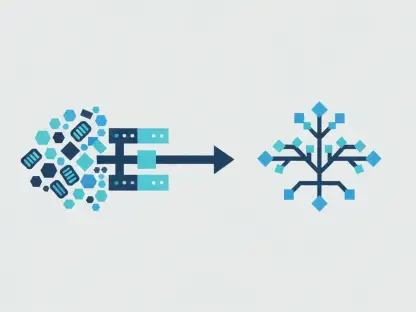Chordoma, a rare bone cancer affecting about one in a million people, has long been a medical enigma. Historically, the lack of understanding and effective treatments has rendered it untreatable. However, recent breakthroughs by Professor Paul Workman and his team offer new hope. This article delves into the pioneering research that could change the future for chordoma patients.
The Personal and Professional Drive Behind the Research
A Personal Connection to Chordoma
Professor Paul Workman’s journey into chordoma research is deeply personal. His mother, Ena, succumbed to this rare cancer when little was known about it. This personal loss fueled his professional dedication to finding a cure. Workman’s experience highlights the emotional and motivational factors driving scientific research. The frustration of losing a loved one to an untreatable disease provides a compelling backdrop to his career.
The story of Workman’s mother is not unique; many researchers are motivated by personal loss. This connection can transform a professional endeavor into a mission. Workman’s determination to understand and eventually find a cure for chordoma has led him down a path of groundbreaking scientific discovery. The intersection of personal and professional life becomes a powerful force, propelling researchers toward breakthroughs that may have seemed impossible.
Professional Milestones
Workman’s career has been marked by significant achievements. As the head of the Centre for Cancer Drug Discovery and chief executive of the Institute of Cancer Research in London, he has been at the forefront of cancer research. His work on chordoma is a testament to his relentless pursuit of medical breakthroughs. Over the years, Workman has built an impressive portfolio of research contributions, focusing on some of the most challenging aspects of cancer.
The professional milestones achieved by Workman and his team have not only advanced our understanding of chordoma but have also paved the way for innovative treatments. Their work underscores the importance of persistent and focused research efforts in tackling rare diseases. From identifying key proteins to developing potential drugs, each milestone represents years of hard work and dedication. These accomplishments highlight the vital role of scientific leadership in advancing medical research.
The Scientific Breakthrough: Targeting Brachyury
Identifying the Key Protein
The discovery of the brachyury protein as essential for chordoma cell survival was a game-changer. This protein, crucial for the cancer cells, became the focal point for developing new treatments. The hypothesis was that blocking brachyury could dismantle the cancer cells. This identification of brachyury marked a significant turning point in chordoma research, offering a clear target for therapeutic intervention.
Understanding that brachyury is a linchpin in chordoma cell survival opened up new avenues for research and drug development. The task of translating this knowledge into practical treatments involves a series of meticulous scientific processes. By focusing on brachyury, researchers are zeroing in on a critical element of the cancer’s biology, providing a focused approach to treatment development. This pivotal discovery has already begun to shape the future landscape of chordoma therapy.
Overcoming the Drug-Proof Challenge
Brachyury was previously considered drug-proof due to its complex nature. However, using advanced techniques like the Diamond Light Source synchrotron, Workman and his team studied the protein in unprecedented detail. They identified multiple targetable sites, paving the way for drug development. This breakthrough in understanding brachyury’s structure has overcome a significant hurdle in chordoma treatment research.
The use of the Diamond Light Source synchrotron represents a cutting-edge approach to studying proteins. This powerful X-ray generator allows scientists to examine the intricate details of brachyury. Identifying targetable sites on such a complex protein required sophisticated technology and expertise. This detailed analysis enabled the team to isolate several promising compounds, which are now being developed into potential treatments capable of attacking brachyury and destroying the protein. The ability to target previously deemed undruggable proteins offers new hope for treating this rare cancer.
Advanced Techniques and Collaborative Efforts
Targeted Protein Degradation (TPD)
One of the sophisticated techniques employed is targeted protein degradation (TPD). This method leverages the cell’s natural disposal system to eliminate harmful proteins. A bifunctional drug binds to the target protein and engages the cellular disposal system to degrade and remove it. The development and application of TPD have revolutionized the approach to targeting brachyury, making it a feasible option for treatment.
Targeted protein degradation exploits the cell’s intrinsic mechanisms for disposing of unwanted proteins, a process that is both efficient and specific. By designing bifunctional drugs, researchers can instruct the cell to not only recognize but also destroy brachyury. This approach marks a significant improvement over traditional methods, which often struggle to address complex proteins. The use of TPD in chordoma research highlights the innovative spirit driving contemporary cancer treatment strategies.
Crystallographic Fragment Screening
Crystallographic fragment screening played a vital role in pinpointing optimal sites for potential drugs to bind on brachyury’s surface. This technique enabled the development of the most effective compounds, marking a significant advancement in the research. By breaking down the protein into smaller, manageable fragments, researchers could identify the best binding sites for drug molecules.
The process involves detailed structural analysis and high-throughput screening methods to determine how small chemical fragments interact with the protein. This granular approach allows for the precise design of drugs tailored to bind effectively to brachyury. The ability to identify and exploit these binding sites provides a robust foundation for creating potent and specific treatments. Crystallographic fragment screening thus represents a critical tool in the fight against chordoma.
The Road to Clinical Trials
From Cell Lines to Animal Models
The journey from discovery to treatment involves several stages. The promising compounds identified need to be tested on chordoma cell lines and then on animal models. This intricate and time-intensive research is crucial for ensuring the safety and efficacy of the treatments. Each stage of testing is designed to build on previous findings, gradually moving closer to a viable human treatment.
Testing on cell lines allows researchers to observe how the compounds interact with chordoma cells in a controlled environment. Following this, experiments on animal models provide insights into how the treatments perform in living organisms, including potential side effects and interactions. This process, although lengthy, is essential for developing safe and effective cancer therapies. The thoroughness of these steps reflects the rigorous standards maintained in medical research.
Human Trials and Future Prospects
Following successful tests on cell lines and animal models, the next step is human trials. This comprehensive process might take up to five years before a viable treatment for chordoma is ready for clinical use. The potential for these treatments to also address other cancers adds to the significance of this research. Human trials are designed to assess the safety, efficacy, and dosage of the new treatments in real-world scenarios.
The transition from laboratory research to clinical application signifies a critical phase in the development of new drugs. Human trials are divided into phases, each designed to answer specific questions about the treatment. These trials involve rigorous monitoring and extensive data collection to ensure that the benefits outweigh the risks. The successful completion of human trials would not only provide a new treatment for chordoma but potentially open doors for addressing other cancers linked to brachyury.
Broader Implications for Cancer Treatment
Brachyury’s Role in Other Cancers
The discoveries made during this research have broader implications. Brachyury appears to play a role in the metastatic spread of other cancers. This suggests that drugs targeting brachyury could also be beneficial in treating more common cancers. The role of brachyury in cancer metastasis underscores the potential impact of this research beyond chordoma.
Understanding brachyury’s function in various cancers opens up new possibilities for treatment strategies. By targeting this protein, researchers might be able to develop therapies that inhibit metastasis, a major challenge in cancer treatment. This broader applicability highlights the importance of fundamental research in identifying versatile targets. The insights gained from studying brachyury could revolutionize the approach to tackling multiple cancer types.
Enhancing Cancer Treatments
The techniques refined to address chordoma might eventually enhance treatments for a wider range of cancers. This potential underscores the importance of continued research and collaboration in the fight against cancer. Advancements in targeted protein degradation and crystallographic fragment screening could be applied to other cancer-associated proteins.
Collaboration across research institutions and disciplines is crucial for translating these findings into broader cancer therapies. The shared knowledge and resources can accelerate the development of new treatments. The application of these cutting-edge techniques exemplifies how innovations in one area of research can have far-reaching implications. The ultimate goal is to improve cancer treatment outcomes, providing hope for patients with various types of cancer.
The Human Element in Medical Research
Workman’s Personal Cancer Battle
Workman’s personal connection to cancer extends beyond his mother’s diagnosis. His father died of bowel cancer, and he himself was diagnosed with prostate cancer in 2022. His favorable prognosis and successful treatment highlight the disparities in cancer treatment outcomes. These personal experiences add a profound dimension to his professional endeavors.
Workman’s journey through his cancer diagnosis and treatment brings attention to the varied nature of cancer prognoses. While some cancers like prostate cancer can be managed effectively with existing treatments, others like chordoma present significant challenges. This disparity underscores the need for continued research into rare and hard-to-treat cancers. Workman’s dual role as a researcher and patient enhances his empathy and commitment to finding solutions.
The Relentless Pursuit of Solutions
Chordoma is a rare type of bone cancer that affects approximately one in a million people. For a long time, this disease has puzzled the medical community due to a lack of understanding and effective treatment options. Historically, chordoma has been considered nearly untreatable, leading to limited hope for those diagnosed with this challenging condition. However, recent advancements in medical research are starting to change this grim outlook. Professor Paul Workman and his dedicated team have made significant breakthroughs in understanding and treating chordoma, bringing renewed hope for patients who suffer from this rare cancer. This article explores the innovative research and discoveries spearheaded by Professor Workman, which have the potential to revolutionize how chordoma is treated in the future. With continuous efforts and further development, these pioneering findings could significantly improve the prognosis and quality of life for chordoma patients, offering a new ray of hope where there was once despair.









